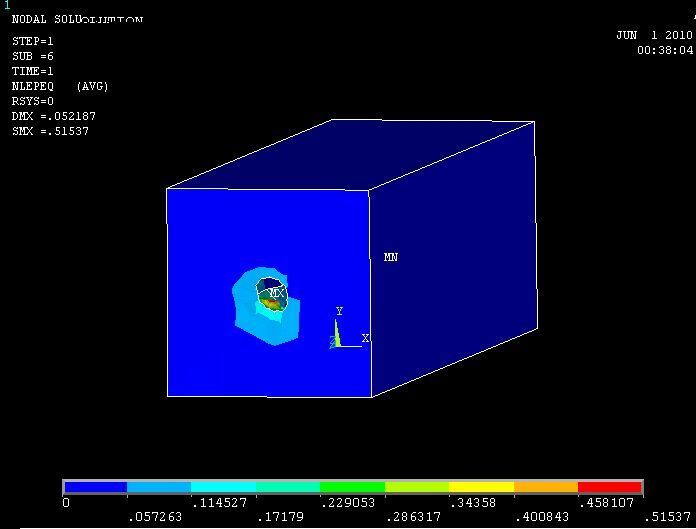
To determine the location and nature of the devastation, I propose to use your device. The device is a four-hinged slats which are fixed at the ends of two tubes. Which are inserted one after another and move freely relative to each other. The basic principle of measurement is based in determining the direction of destruction and on his determination of the direction of the normal stresses.
 s
s
To do this, using the device to find the zone with maximum destruction of the walls of the wells, sequentially measuring the diameter of the hole. And in a change in the diameter of the large side, to determine angle pair of levers on the azimuth. The measurements were carried out zones of influence and develop within a single layer of rock. Number of dimensions 5-10 wells at one site. The direction of the normal stress is perpendicular to the direction of destruction. The main problem is the problem of measuring differences in the destruction of the borehole walls all of erosion, the use of tunneling tools and mowing of rocks from destruction by the impact of rock pressure.
Main criteria for selection are:
1. One of the two measurements at the same depth should be close to the design diameter of the hole
2. The upper and lower part of the destruction should be clearly identified.
3. Diameter measurement should not exceed the diameter of the hole by more than 10%
4. The slope of the well should not exceed 10 °.
5. The length of the fracture zone should not exceed 1 m.




This method of determining the stress is widely used abroad, in particular 19% of the measured database of world tensions.
Second part of my work dedicated to the modeling of stress deformed condition of mountain. As the object of study is not used a large array of rocks (500-1000m.) With steeply dipping layers of different capacities and structures.

In geological history were formed about 20 tectonic processes. We simulate the stress-strain state of the array and observe the processes in the present tektonogeneze This work has been done for a better presentation of the formation mechanism of disturbances in the Earth's crust, uplift and subsidence of large areas of soil, mountain building, etc. And also for the study of processes occurring at the same time in the strata. To carry out planned work creates a digital model of the deposit. Getting to work, determined the size of the model, the well diameter and features an array
When creating a model for each stratum in the program impose the parameters:
• Poisson's ratio;
• Modulus of elasticity;
• Strength;
• The angle of internal friction;
• Angle fluidity;
• Density;
Boundary conditions by fixing realizes conventional boundaries, the creation of free boundaries, the application load on the individual border. In the present case is very important to simulate the tectonic stresses that easily allows finite element method.
Boundary conditions by fixing realized by conventional boundaries, the establishment of free boundaries, application of the load on individual boundaries. In this case, it is important to simulate the tectonic stresses that easily allows a finite element method.
The models reviewed.
Review of research on the topic in DonNTU
Mountain Institute of Donetsk National Technical University is one of the leading scientific organizations, which deals with geomechanical processes occurring in the coal containing the array as a result of underground mining. In surveying service coal companies responsible for the safe and efficient mining. The department Surveying in the study of stress state of a massif, its prediction and control of rock pressure in order to secure mining deal Ph.D. prof. Nazimko VV
Review of research on the topic in Ukraine
The territory of Ukraine research geomechanical processes taking place in the coal containing the array as a result of underground mining, are engaged in scientific research institute UkrNII National Academy of Sciences and Department of Physical and Technical Problems DonFTI NAS.
Main results
Be improved method for determining the orientation and magnitude of rock pressure component complex method
References
- Борисов А.А. Механика горных пород и массивов. - М.: Недра, 1980. - 306 с.
- Гинтов О.Б., Исай В.М. Тектонофизические исследования разломов консолидированной коры. — К.: Наукова Думка, 1988. 120 с.
- Batdorf S.B.,Budiansky B.A. mathematical theory of plasticity based on the concept of slip// Nat.Adv.Com.Aeron.:Tech.Notes.-1949.-P.134-155
- Bott M.H.P. the mechanics of oblique clip faulting\\Geol.Mag.-1959.-№96.-P.109-117
- Mc.Kensie,dan P.dan. The relation between fault plane solution for earthquakes and the direction of the principal stresses\\Bull.seism.Soc.Amer.-1969.-59,N2.-P.591-602
- Гавриленко Ю.Н. Комплекс программ метода конечных элементов (МКЭ) для моделирования и анализа процессов деформирования массива горных пород и земной поверхности в условиях пластовых месторождений // Доклады III научно-технической конференции вузов Украины «Маркшейдерское обеспечение горных работ ». – Донецк: - 1995. – С.31-35.
- Гутерман В.Г.,Хазан Я.М. Об общих вертикальных движениях континентов.Кинематический аспект//Там же.-1983.-5,№1.-С.14-23
- Лабасс А. Давление горных пород в угольных шахтах // Вопросы теории горного давления. - М.: Углетехиздат, 1961. с. 59-83.
- Басов К.А. Ansys: справочник пользователя - М.:ДМК Пресс, 2005.-640с
- Гущенко О.И. Метод кинематического анализа структур разрушения при реконструкции полей тектонических напряжений//Поля напряжений и деформаций в литосфере.-М.:Наука,1979.-С.7-25
- Гущенко О.И.,Гущенко Н.Ю.,Мострюков А.О. и др. Тектонический стресс-мониторинг и поля напряжений Причерноморского региона//Наук.праці НТУ.Сер.гірн.-геол.-2001.-32.-С.104-117
- Гущенко О.И.,Кузнецов В.А. Определение ориентации и соотношения величин главных напряжений по совокупности направлений сдвиговых тектонических смещений//Поля напряжений и деформаций в литосфере.-м.:Наука,1979.-С.60-66
- Басов К.А. Ansys в примерах и задачах - М.:Компьютер Пресс, 2002.-228с.
- Вольфсон Ф.И., Яковлев П.Д. Структуры рудных полей и месторождений. – М.: Недра, 1975, 263 с.
- Рябоштан Ю.С. Некоторые особенности геологии угольных отложений и изучение их с помощью геофизических методов; Тр. Международного конгресса по стратиграфии и геологии карбона. – М.: Наука, 1979, т. 5, с. 185-188
- Тектонофизика
- Методы реконструкций напряжений
